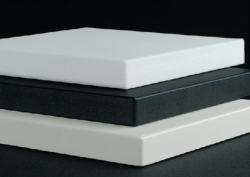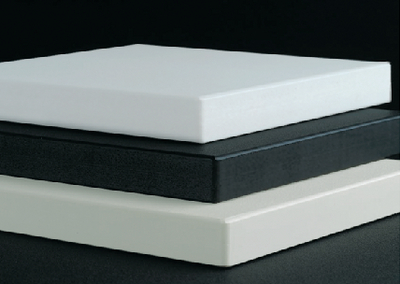King Starboard, Marine Grade Polymer Building Sheet - King Plastic
The original and industry standard in marine-grade polymer.
King StarBoard can withstand the harshest marine conditions without warping, rotting or discoloring like teak and other solid woods. And it will not de-laminate like wood laminates when exposed to water or humidity. Manufactured through an advanced proprietary process called K-Stran, King StarBoard has superior flatness and consistency.
This marine building sheet has a low maintenance matte finish that hides scuffs and scratches, makes cleaning easy, and means repairs and refinishing are a thing of the past.
Applications:
- Bow Pulpit
- Countertops
- Frames and Trim
- Furniture
- Grab Rails and Handles
- Hatches and Doors
- Rod and Cup Holders
- Steps and Dock Boxes
- Tray Tables
King StarBoard and King StarBoard ST (Video)
Information on the King StarBoard polymer sheet by King Plastic Corporation ... read more
King StarBoard and King StarBoard ST are the ultimate building materials for outdoor and wet environments. From the original marine grade polymer sheet to luxurious outdoor living and kitchen areas made with King StarBoard ST to exceptionally clean and durable medical cabinets and case goods.
The King StarBoard family of products has evolved over decades to help you set your imagination free to design and build applications that make people’s lives better.
The environmentally stabilized sheets act like wood and last a lifetime. They will never rot, swell, or delaminate and they are available in a variety of designer colors. Imagine what you can build with King StarBoard.
Video Transcription
King Plastic Corporation pioneered the first marine grade polymer sheet, King StarBoard, which remains the dominate brand in the marine industry today. Since 1968 our innovations combined with our customer’s imaginations have led to the invention of entirely new categories of polymer sheet products.King StarBoard and King StarBoard ST are the ultimate building materials for outdoor and wet environments. From the original marine grade polymer sheet to luxurious outdoor living and kitchen areas made with King StarBoard ST to exceptionally clean and durable medical cabinets and case goods.
The King StarBoard family of products has evolved over decades to help you set your imagination free to design and build applications that make people’s lives better.
The environmentally stabilized sheets act like wood and last a lifetime. They will never rot, swell, or delaminate and they are available in a variety of designer colors. Imagine what you can build with King StarBoard.
Bending and Thermoforming King Starboard Plastics (Video)
Here is a video describing the best ways to bend or conform King Starboard plastic. ... read more
Video Transcript
One of the best things about King's plastic polymer sheet is that they work like wood. They're easy to fabricate with common woodworking tools and techniques.
However, one fabrication advantage that our polymer sheet has over wood is the ability to be easily bent and thermoformed. This short video will show you how.
Always wear protective gloves and do not place your hands or arms on the work station.
First, the part to be bent needs to have a 90-degree groove right in the material which will form the finished bend location.
The groove should be cut to a depth at least about 100th to 50,000th of an inch of material. More thickness for a rounder corner, less thickness for a sharper corner.
Pre-heat the bending bar to a temperature of about 300 to 350 degrees Fahrenheit when bending high-density polyethylene. Place the part on the bending bar and apply weight of about 10 to 15 pounds per foot of a part being bent.
For example, if you are bending a 24-inch part, a weight of 20 to 20 pounds must be applied to the part uniformly to hold the part down to the bending bar.
The weight may need to be adjusted if the temperature of the bar is warmer or cooler, or if the weight is needed to force the plastic edges to be in complete contact with the bar.
The part needs to be in contact with the bar for 60 to 120 seconds depending on the temperature of the bar. The best way to tell if the part is ready to be removed from the bar is to look for a bead forming under the part when the plastic meets the bar.
When a small bead forms the full length of the part in its location on both sides, it's ready to be removed. Pull the part off the bar or grab at one end and pulling up, peeling the part off the bar while holding the bar down securely.
Plastic will tend to stick to the bar. Small amount of molten plastic wrapped on the bending bar is common.
After the part is removed from the bar, neatly bend the part by placing it in a fixture or jig, or to hold the part in its final position.
It's important to hold the part in the jig for a minute or two to allow the molten plastic to cool. Allow it to time to completely cool it.
Sometimes the part will relax slightly after removing it from the jig. You may find that you have to overrun the part to get the final bend correct. Some experimentation may be necessary.
Forming a radius can also be done by using a heat gun using a back and forth motion across the length of the sheet, both top and bottom, till the material is soft enough to start bending.
Even the gun at a distance of at least 8 to 12 inches. Do not get the heat too close to the material as blistering may occur.
Flicker the material the longer it'll take to form a desired radius and you might need to wear thicker material.
Once the material has been bent to the desired angle, clamp into place until pulled to room temperature. The product should be allowed to cool naturally.
If you have any questions, please contact your distributor or King Plastic. Thanks for watching.
Video Transcript
One of the best things about King's plastic polymer sheet is that they work like wood. They're easy to fabricate with common woodworking tools and techniques.
However, one fabrication advantage that our polymer sheet has over wood is the ability to be easily bent and thermoformed. This short video will show you how.
Always wear protective gloves and do not place your hands or arms on the work station.
First, the part to be bent needs to have a 90-degree groove right in the material which will form the finished bend location.
The groove should be cut to a depth at least about 100th to 50,000th of an inch of material. More thickness for a rounder corner, less thickness for a sharper corner.
Pre-heat the bending bar to a temperature of about 300 to 350 degrees Fahrenheit when bending high-density polyethylene. Place the part on the bending bar and apply weight of about 10 to 15 pounds per foot of a part being bent.
For example, if you are bending a 24-inch part, a weight of 20 to 20 pounds must be applied to the part uniformly to hold the part down to the bending bar.
The weight may need to be adjusted if the temperature of the bar is warmer or cooler, or if the weight is needed to force the plastic edges to be in complete contact with the bar.
The part needs to be in contact with the bar for 60 to 120 seconds depending on the temperature of the bar. The best way to tell if the part is ready to be removed from the bar is to look for a bead forming under the part when the plastic meets the bar.
When a small bead forms the full length of the part in its location on both sides, it's ready to be removed. Pull the part off the bar or grab at one end and pulling up, peeling the part off the bar while holding the bar down securely.
Plastic will tend to stick to the bar. Small amount of molten plastic wrapped on the bending bar is common.
After the part is removed from the bar, neatly bend the part by placing it in a fixture or jig, or to hold the part in its final position.
It's important to hold the part in the jig for a minute or two to allow the molten plastic to cool. Allow it to time to completely cool it.
Sometimes the part will relax slightly after removing it from the jig. You may find that you have to overrun the part to get the final bend correct. Some experimentation may be necessary.
Forming a radius can also be done by using a heat gun using a back and forth motion across the length of the sheet, both top and bottom, till the material is soft enough to start bending.
Even the gun at a distance of at least 8 to 12 inches. Do not get the heat too close to the material as blistering may occur.
Flicker the material the longer it'll take to form a desired radius and you might need to wear thicker material.
Once the material has been bent to the desired angle, clamp into place until pulled to room temperature. The product should be allowed to cool naturally.
If you have any questions, please contact your distributor or King Plastic. Thanks for watching.





 Boats for Sale
Boats for Sale Advice
Advice







